Introduction: The “Close, But Not Quite” Feeling
You’ve been there. You’ve spent hours scrolling through Pinterest, found the perfect haircut, and confirmed with a dozen online guides that yes, this “textured lob” is the “ideal cut for your heart-shaped face.”
You take the photo to your stylist. You walk out of the salon, and it looks incredible. The angles are perfect. The volume is just right.
Then, a week later, you try to style it yourself. It just… sits there. It’s heavy where it should be light, flat where it should have volume. The celebrity in the photo was all soft, beachy waves, but your hair is either pin-straight and limp or has sprung up into tight, bouncy curls. You both have a “heart-shaped face.” Why doesn’t it work?
The answer is simple: The article you read, and the hundreds of others just like it, missed the single most important variable: Your hair texture.
The celebrity’s hair was fine and had a 1C or 2A pattern (a slight, loose wave), while yours might be dense and 3B (bouncy, defined curls). The truth is, you didn’t get the same haircut. You couldn’t have. Because the exact same cut on two different textures will result in two completely different visual shapes.
We’ve been taught to think of our hair as a frame (the cut). We need to start thinking of it as a tool (the texture). Your hair’s natural pattern—its lines, its volume, its density, and the way it reflects light—is the most powerful optical contouring kit you will ever own.
This article will introduce you to the “Texture Geometry Rule.” It’s a new way of seeing your hair, not as a “problem to be managed,” but as an asset to be leveraged. You will learn to stop fighting your texture and start using it to strategically sculpt, soften, and rebalance your features for a look that is harmoniously, authentically you. So stop asking what cut fits your face shape. It’s time to learn why your texture is the real secret to a perfectly balanced look!

A high-fashion, editorial triptych featuring the same square-faced model with a chin-length bob, styled pin-straight (Type 1A), wavy (Type 2C), and coily (Type 4A) to visually demonstrate the impact of texture on face shape.
Part 1: The Old Rules vs. The New Truth
Why the “Face Shape” Rule Is Broken
For decades, beauty magazines have pushed a simple, two-dimensional formula: “Round faces need long hair,” “Square faces need waves,” “Heart-shaped faces need a lob.”
This advice isn’t wrong, but it’s fundamentally incomplete. It fails because it treats hair as a static outline, like a drawing. It completely ignores the three-dimensional reality of your hair: its density, its “visual weight,” and its natural growth pattern.
This old model promotes the idea of “fixing” or “hiding” your face shape, as if it’s a flaw. The new truth is about balance. It’s not about changing your face; it’s about using your hair’s unique properties to bring all your features into harmony.
The New Truth: Texture Speaks Louder Than Cut
A great haircut doesn’t create a shape; it releases your texture’s natural shape. This is the core of Texture Geometry. To understand your hair’s power, you need to know its three core components:
- Line Direction: Does your hair fall in vertical lines (straight), “S” shapes (wavy), or circles/spirals (curly/coily)? The line your hair creates is the most powerful tool for counteracting or complementing your facial lines.
- Visual Weight & Volume: Where does your hair naturally want to be? Fine, straight hair often has its “weight” at the ends. Curly hair has its weight where the curl is widest. Coily hair can build weight and volume in any direction, defying gravity.
- Light Reflection: Does your hair absorb light or reflect it? Pin-straight hair has a high-sheen, mirror-like surface that reflects light in a solid, “liquid” sheet. Coily hair, with its beautiful twists and turns, absorbs light, giving it a rich, dense visual presence.
Your Texture Isn’t a “Problem,” It’s Your “Tool”
Let’s reframe the conversation. For too long, “frizzy,” “flat,” “puffy,” or “unruly” have been used as negative terms. These are not flaws; they are simply descriptions of your hair’s power.
“Frizz” is just your hair’s desire to create a soft, voluminous, light-diffusing halo. “Flat” is your hair’s power to create a sharp, liquid, vertical line.
The gravity-defying shape of a 4C coil is a sculpting tool that 1A hair simply doesn’t have. The sharp, liquid-like “slice” of 1A hair creates a lengthening effect that 3C hair can’t. Every single texture, from the straightest to the tightest coil, has its own unique geometric power. The secret is knowing how to direct it.
Part 2: The 4 Principles of Texture Geometry
This is the core of the new rule. Let’s identify your hair’s superpower.
Principle 1: Type 1 (Straight Hair) = The Architect’s Line
- Geometric Power: Creates strong vertical lines.
- Optical Effect: This texture lengthens, elongates, and “slices.” It’s like a curtain of liquid, drawing the eye vertically. Because its flat cuticle reflects so much light, it creates a solid, high-sheen, “unbroken” shape.
- Best For: Creating the illusion of length on round or wide faces. Cutting a “corner” into a round face with a sharp, angled bob. Creating sleek, angular, “power” looks that highlight strong bone structure.
- Watch Out For: This texture can easily “drag down” a long or oblong face, making it appear longer. On a very angular face, it can look “severe” if not softened with face-framing layers.
Principle 2: Type 2 (Wavy Hair) = The Softening Blender
- Geometric Power: Creates diagonal and “S” shaped lines.
- Optical Effect: This is the ultimate “softening” tool. The “S” shape is a natural line-breaker; it diffuses and blurs. It’s perfect for counteracting any harsh angles in the face. It scatters light rather than reflecting it directly, creating a gentle, romantic aura.
- Best For: Softening a strong, square jawline. Adding gentle, balancing width to a narrow (long) face. It’s the “go-to” for anyone wanting to “blur” the edges.
- Watch Out For: The wrong layers can cause wavy hair to “poof” into the dreaded “triangle” shape, creating unwanted volume at the widest part of a round or heart-shaped face.
Principle 3: Type 3 (Curly Hair) = The Circular Balancer
- Geometric Power: Creates circular and spiral lines.
- Optical Effect: This texture builds volume horizontally and creates roundness. Curls act like “visual dots” that draw the eye outward, away from the center of the face. This makes it a fantastic tool for adding width and balancing proportions.
- Best For: Building width to balance a heart-shaped face’s narrower chin or a long face’s length. The circular patterns beautifully soften prominent features, like a strong nose or a pointed chin, by adding a competing, softer shape.
- Watch Out For: Without proper layering, the volume can “overwhelm” a small or petite face. On a round face, you must control the volume to avoid adding more roundness at the cheeks.
Principle 4: Type 4 (Coily/Kinky Hair) = The 3D Sculptor
- Geometric Power: Creates angular, cloud-like, or “Z” shapes. This is the only texture that can defy gravity and build shape upward and outward equally.
- Optical Effect: This is not a “frame”—it is pure 3D sculpture. It can create an entirely new silhouette. By absorbing light, it has a rich, dense visual weight that can anchor or balance any feature on the face. It can be cut into sharp angles, soft halos, or powerful, tall shapes.
- Best For: Building angular volume (like a tapered cut or a defined ‘fro) to counterbalance the curves of a round face. Creating height to elongate any face shape. Crafting a powerful, symmetrical “halo” that puts the facial features in beautiful, clear focus.
- Watch Out For: Shrinkage is a key factor. The visual shape of the hair when dry is far more important than the length of the strands. This texture requires a stylist who cuts “dry” and understands how to build shape.
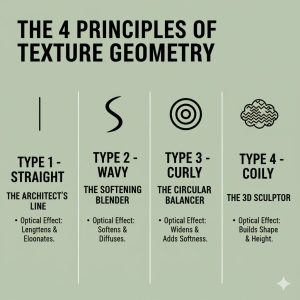
A clean, modern infographic titled, “The 4 Principles of Texture Geometry,” detailing the optical effects of straight, wavy, curly, and coily hair types with corresponding icons.
Part 3: The Application: Texture Contouring by Face Shape
Now, let’s put the principles into practice. Here’s how to apply the Texture Geometry Rule to your face shape—the right way.
Section 3.1: Rebalancing the ROUND Face
- Goal: Create the illusion of length and add definition or angles.
- Straight (Type 1) / Wavy (Type 2) Hair: The old advice was “go long,” and it’s not wrong. The vertical lines of a long, sleek style “slice” the roundness. A deep side part is your best friend, as it creates a diagonal line that cuts a “corner” into the rounded forehead, adding instant definition.
- Curly (Type 3) / Coily (Type 4) Hair: This is where the old rules failed, but the new rules excel. The old rule said “avoid volume.” The new rule says: Build UP, not OUT. The power of coily and curly hair is its ability to build height. A tapered cut that concentrates volume at the crown, a high puff, or a cut that is longer on top than on the sides will draw the eye upward, elongating the face beautifully. The key is to avoid chin-length bobs that add volume at the widest part of the face.
Section 3.2: Softening the SQUARE Face
- Goal: Soften the sharp, angular lines of the jaw and forehead.
- Straight (Type 1) Hair: This can be challenging, as vertical lines can run parallel to the square jaw and emphasize it. The solution is soft layering. “Invisible” or “internal” layers and soft, face-framing pieces (like ’70s-style curtain bangs) will “break” the solid curtain of hair and add movement that diffuses the angles.
- Wavy (Type 2) / Curly (Type 3) Hair: This is your superpower. Your hair’s natural “S” and “Circular” lines are the direct geometric opposites of a square shape. Let your waves or curls fall around your jawline. That softness will directly counteract the hard lines, creating a beautiful, harmonious balance.
- Coily (Type 4) Hair: A large, soft, rounded “afro” shape is perfect for this. It encases the square angles in a “halo” of softness. This shifts the focus from the jawline to the entire face (especially the eyes and lips), which are now beautifully framed.
Section 3.3: Balancing the HEART Face
- Goal: Add “visual weight” and width at the chin/jaw area to balance the wider forehead.
- Straight (Type 1) / Wavy (Type 2) Hair: The classic “lob” (long bob) that ends at or just past the chin is ideal. You need volume that starts at the chin and goes down. Avoid short, choppy layers or heavy volume at the crown, which will only emphasize the widest part of your face.
- Curly (Type 3) / Coily (Type 4) Hair: Your texture is perfect for this. A cut that is “bottom-heavy” is your goal. That “triangle” shape that so many other face shapes try to avoid is actually your ideal silhouette. A cut that allows your curls or coils to build width and volume around your chin and jaw will fill in that narrower space perfectly, creating flawless balance.
Section 3.4: Supporting the OVAL Face
- Goal: Maintain the face’s natural balance.
- The Rule: If you have an oval face, you’ve already won the genetic lottery of facial geometry. The “rule” here is simple: Don’t fight your texture. An oval face can wear almost any texture or style, so the goal is to choose a cut that celebrates your natural pattern. This is less about “fixing” and all about hair health, definition, and letting your texture live its best life. Your main goal is to avoid any extreme styles (like ultra-heavy bangs or extreme height) that might throw off your natural symmetry.

An empowering portrait of a confident model with a round face and Type 4B/4C coily hair styled with structured volume and height at the crown to optically elongate her face.
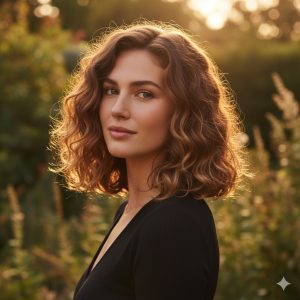
A cheerful, bright photo of a model with a heart-shaped face and Type 3B/3C curly hair in a “bottom-heavy” style, adding visual weight to the narrower chin.
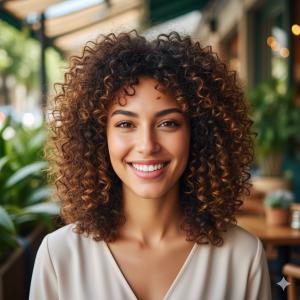
A “soft focus” or “golden hour” editorial-style photo of a model with a defined square face and a Type 2C/3A wavy/curly “lob,” with waves gently diffusing the jawline.
Part 4: The X-Factors: Beyond Texture & Shape
Texture Geometry is the most important rule, but it’s not the only one. To truly master your look, you must consider these final “X-factors.” This is what takes your look from “good” to “perfectly you.”
- Density (Fine, Medium, Coarse): This is not the same as texture. You can have fine (thin strands) coily hair, and you can have coarse (thick strands) straight hair. Density affects volume. Fine hair may need layers and products to build volume, while coarse hair may have volume built-in and need techniques to control it.
- Porosity: How does your hair absorb and hold moisture? High-porosity hair (which absorbs quickly) may frizz more easily or lose its shape, requiring more moisture-locking products. Low-porosity hair (which repels moisture) might be sleeker but can be harder to style.
- The Cut (The Release): The cut is the final, crucial piece. Your stylist’s job is not to give you “a bob.” Their job is to use their scissors to release your texture’s natural pattern in a shape that suits you. A stylist who understands how to cut for texture (e.g., a dry cut for curls, a slide-cut for waves) is essential.
- The “You” Factor (Personality): Finally, who are you? A sharp, angular, asymmetrical cut might “violate” the rules for a square face, but if your personal style is bold, edgy, and architectural, it will look amazing. Your hair is an expression of your identity. These rules are your tools—you are the artist.
Conclusion: Your Texture, Your Signature
It’s time to throw out the old, restrictive rulebook. Stop asking, “What haircut is good for my face shape?” and start asking a better question: “How can my unique texture bring my features into harmony?”
Your hair’s natural pattern is not a bug to be fixed or a flaw to be “tamed” into submission. It’s the most powerful, dynamic, and personal design feature you have. Whether it’s the sleek, liquid line of 1A hair, the soft blend of 2B waves, the joyful bounce of 3C curls, or the sculptural power of a 4C coil, your texture is your signature.
It’s not something to fight. It’s something to be understood, celebrated, and finally, unleashed with a strategic cut and the confidence of knowing its true power.
Share this article with someone who is still fighting their beautiful, natural hair. Then, go look in the mirror. What is your texture’s geometry?



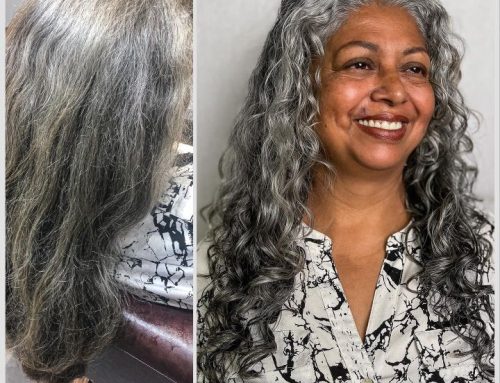
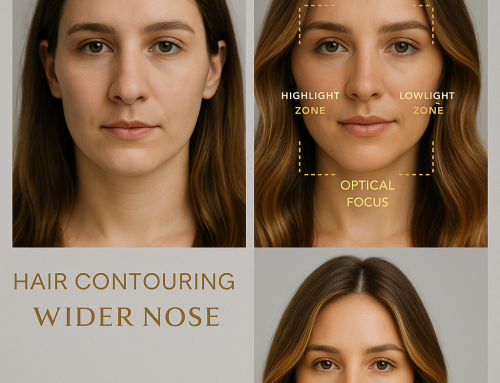
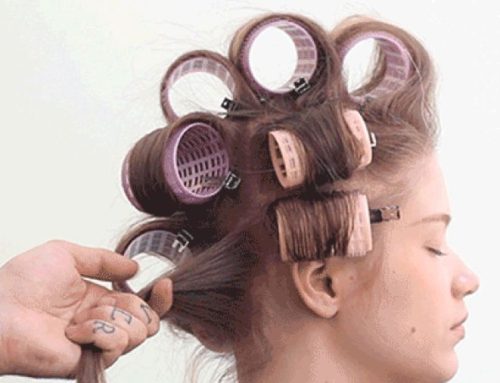

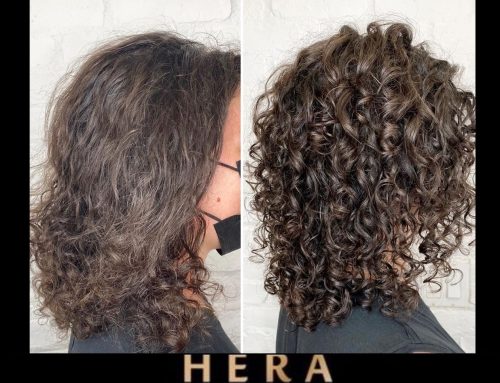
Leave A Comment